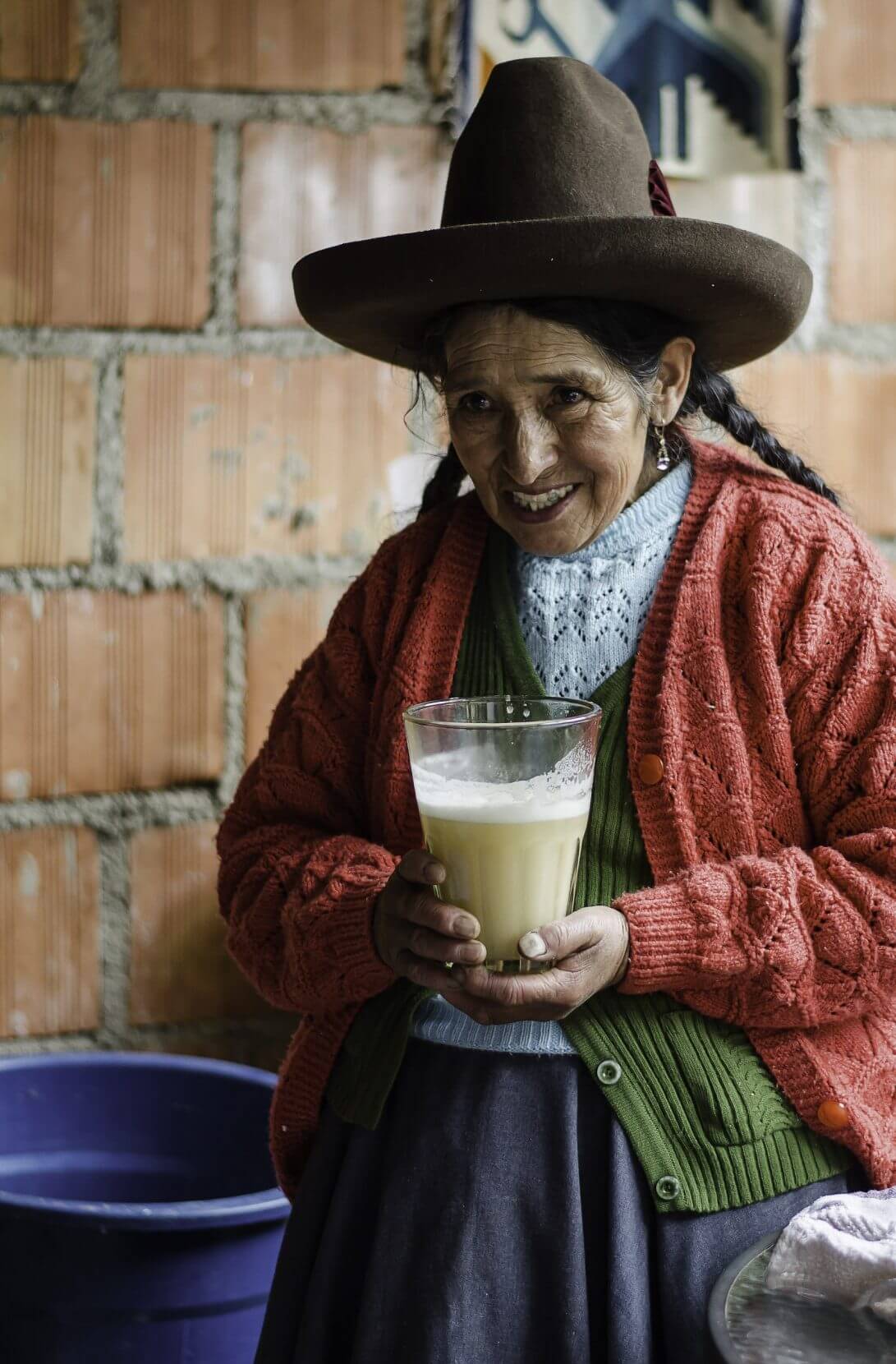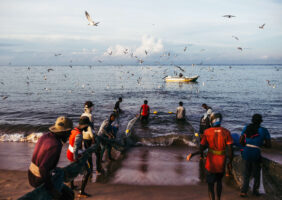Support Hidden Compass
We stand for journalism, science, history, and hope. Make a contribution to Hidden Compass and stand with us.
When the bar owner placed the lukewarm glass of cloudy, phlegm-colored beer in front of me, I could tell the description “it’s an acquired taste” would be an understatement. I had crisscrossed a Peruvian town for six hours searching for this drink, but now I hesitated to take a sip, even as the dry thirst in the back of my throat begged for relief. Was this really chicha, the legendary, spit-fermented corn beer once used to appease angry gods?
The first time I heard about chicha, I was sitting on my couch in Austin, watching a history show describe how young girls were forced to chew corn, spit it into a bucket, then let that saliva-corn mixture ferment into a sacrificial beer. These were no ordinary girls — they were the “chosen ones” — handpicked by Incan kings for their beauty, youth, and purity. Known as the Virgins of the Sun, they were taken from their villages at eight years old and hidden away in temples for years, chewing and spitting their way through adolescence with their chastity intact. Once their beauty faded — usually by the advanced age of 14 — Incan high priests brutally murdered them on mountaintops in sacrifice to the gods.
Known as the Virgins of the Sun, they were taken from their villages at eight years old and hidden away in temples for years, chewing and spitting their way through adolescence with their chastity intact.
Over the centuries, that holy elixir slowly morphed into a sour, homemade Andean beer, known for its “acquired taste.” I don’t have many life goals, but once I learned you could still find chicha in the back alleys of Peru, I knew I needed to try it. Reviews put it at the bottom of Peru’s beverage hierarchy. But how bad could it be? So, when I arrived in Peru, I had two goals: hike Machu Picchu and taste chicha.
~~
I began in the Andean mountain town of Cusco, once the capital of the largest empire in the pre-Colombian Americas, now a tourist mecca. The streets were full of clothing stores selling everything alpaca, overly aggressive guides hawking tours of Machu Picchu and traditionally dressed women sitting on sidewalks with their llamas, waiting for tourists to pay for their pictures.
Built in the shape of a puma, a sacred animal in Incan mythology, the city became the capital of the Tawantinsuyu Inca Empire in the 15th century. All roads in the 2,500-mile territory ran through the ruling city until the Spanish arrived. With the bitterness of a recent heartbreak, locals here can tell you the exact year, 1532, that the Spanish conquistador, Francisco Pizarro, conquered the last true Incan, King Atahualpa. Once the conquistadors defeated the Incas they pillaged, razed and burned everything they could. Many of the Incan temple walls — being the most finely worked stone structures of any ancient civilization — were impossible to destroy, so the Spanish built on top of them. Throughout the city, large, perfectly fitted Incan stones bed-skirt many of the Colonial brick buildings.
Like in any good Latin American city, the Spanish had placed a grand cathedral in the middle of town as a constant justification of why they had annihilated a civilization (God wanted it) and why they had stolen thousands of pounds of gold from the indigenous population (God likes shiny things). So naturally, the historic Cathedral Basilica — an ornate, gold-drenched vault of stones erected atop the foundation of an Incan temple — was where I started my official tour of Cusco.
Toward the back of the massive, glittering cathedral, hung somber, Renaissance-style oil paintings seemingly identical to those hanging in Italy. However, on closer inspection, the Last Supper Judas sure did resemble that evil conquistador Francisco Pizarro. And it wasn’t bread that Jesus and his disciples had all gathered around: It was a roasted guinea pig, feet up, ready to be eaten. Guinea pig, or cuy as it is called in Peru, is a delicacy. Whole sections of Incan cities were, and still are, devoted to raising guinea pigs to be skewered whole, then fried or roasted over a spit. Cuyes have become a national mascot: Gift shops are full of cuy stuffed animals and kitschy shirts with cartoons of Cuy Marley, a guinea pig dressed up as a Rastafarian, or Cuytallica, a Metallica-like band with four hardcore guinea pigs.
Next was Cusco’s main market, the Mercado de San Pedro. Row after row of vendors sat behind tables filled with fruits, vegetables, quinoa, cheese, flowers, dry goods, vitamins, and indigenous cures for everything from erectile dysfunction to heartbreak to good old-fashioned insomnia. Meat isles in these mercados always make me consider becoming a vegetarian. Horse snouts, rib cages of unidentified animals, and pigs’ heads sat in the open air. Flies buzzed around piles of bone, blood, and flesh. Looking away as an elderly man struggled to hack through a carcass with a flimsy saw, I asked my guide about chicha.
“There are two types of chicha,” she said. “There is the chicha morena, which does not have alcohol and is made from purple corn, and there is chicha de jora, or corn beer.”
She went on to describe how Sacred Valley locals around Cusco make chicha de jora, but I did not understand most of it. I speak Spanish well enough for people to assume I speak Spanish very well. My guide began quickly describing something about drying corn, something, something, something, waiting for sprouts, something, something, a bucket, something, the whole process takes about two weeks. I hoped the answer to my next question hadn’t just been described in painstaking detail.
“Where would I find the original chicha now?” I asked.
“I am not sure,” she said. “You can drive around the Sacred Valley and look for the chicharías with red balloons, but not many people make it anymore. It is more of an ancient pastime. Now if people want beer they can go to their local store and buy it.”

A woman holds a glass of chicha de jora. The phlegm-colored beer of the Incan empire was once made from corn and the spit of Incan virgins. Photo: Mabelín Santos.
That afternoon, I wandered the city and asked locals where I could find a chicharía. Without exception, they all told me “two blocks that way,” pointing in any direction, “and one block over.” I find that when asking people directions in Peru, everything is two blocks away and one block over until you get there.
~~
Finding chicha was harder than I thought, so I turned to Harly, an expat from New York who ran bar-hopping tours. If anyone knew where to find chicha in a language I could understand, it would be this guy.
I met Harly in San Blas, a neighborhood full of reiki treatments, yoga centers, vegan restaurants, rave kids, and hippies selling handmade jewelry on sidewalks. Everyone was looking for something to make them feel better, whether it was animal-free food or psychedelics, and most of the time it was both.
“So, you want to try chicha?” Harly asked.
“Yes.”
“You know the real chicha is bathwater shit?”
“Yes, I do,” I said. “That is what I want to try.”
We walked for fifteen minutes, through La Plaza de Armas, past the busy Avenida de Sol, to La Cusquenita Pikanteria Tradicional, a large, traditional, banquet-style restaurant. At 3 p.m. on a Friday, almost every seat was taken by beer-drinking, cuy-eating Cucscanas.
“Does anyone work in this town?” I asked.
“I don’t know,” Harly said.
Harly ordered us two Chicha de Frutilladas. The pink drink was made with chicha beer, but strawberries, sugar, and water were added during fermentation to cut down on the sourness of the beer. I picked up the quart-sized glass with both hands to move it for a picture, and some of the pink, foamy liquid spilled on the floor.
“That is a sacrifice,” Harly said.
It was customary for the Incan king Tupac Amaru — yes, like the rapper — and others to pour out, or sacrifice, the first sip of chicha to Pacha Mama (Mother Earth) as a sign of respect and gratitude for providing them with corn to make the beer. I felt drawn to my college years when, while listening to the rapper Tupac, my friends and I would pour out the first sip of our 32-ounce beer on San Diego beaches for our dead homies.
I needed to find something more authentic — with fewer strawberries.
~~
After a series of unsuccessful forays through restaurants, alleys, ditches and police stations, our search for chicha was bordering on six hours. The streets were dark and slick from a recent rain and I was tired. I was about to suggest that we call it a night when a man walking by told us there was a chicharía nearby — two blocks down… and one block over.
I had little faith in the Peruvian “two blocks down and one block over,” but as we walked we saw a single light shining dimly on the crumbling walls, and a blue door that was halfway open. There was no red balloon, but there was a light on in the back. We ducked through the low doorway and into a room filled with a few tables, low wooden stools, and a broken-down Panasonic television resting on an empty bookshelf.
A group of four men eyed us suspiciously as we sat at the table closest to the door. A short, tired-looking Peruvian woman took our order and came back with two glasses filled to the brim with what looked like bathwater. The plastic glasses were slick with grime, having been washed without hot water after too many dirty hands.
Served at room temperature, the first sip of the sludgy liquid had a faintly familiar sour taste, making me immediately take another sip to see if I could figure it out. The only beverages I could compare it to were the “bar mat” shots a bartender I worked with made servers drink when they lost a bet. He would pick up the rubber bar mat and pour all the liquor collected from spilt drinks into a shot glass.
“You know the real chicha is bathwater shit?” “Yes, I do,” I said. “That is what I want to try.”
“What do you think?” Harly said, smiling as he watched me take that first sip.
It’s often said that chicha’s “acquired taste” is best matched with local cuisine. In my opinion, it is effing disgusting and any amount of local fare could not change that fact.
“Well, I don’t love it,” I said.
Stray dogs ran in and out of the open door. Occasionally, in between serving customers and feeding her children in the back room, the owner ran out with a stick to shoo the dogs away. They would leave, until the coast was clear, then sneak back in to resume their positions under the tables, sniffing for scraps.
Harly and I talked, as we had all afternoon, about life, travel, business, and relationships. The conversation was grand, and I wanted to continue toasting our accomplishment, but I could not enjoy my beverage. There was nothing refreshing about the sour beer as it sat rotting in my stomach. Halfway through my first and only glass, we asked for the check.
“Four soles,” said the woman.
“Four soles? That is like, 75 cents each for these huge beers! That is amazing!” I said to Harly, momentarily forgetting that I thought it was the grossest thing I had ever tasted.
As I put money on the table, I thought of those young, beautiful maidens, spending their days chewing and spitting, chewing and spitting, to make this corn elixir for the gods to whom they would be sacrificed. Then I thought, if I lived in a time when this was the best drink available, I would want to be sacrificed too. It is time for a new life goal.
Jennifer Simonson
Jennifer is a Texas-based writer who travels in search of good conversation, tasty ice cream, fast water slides, and harsh moonshine.
Never miss a story
Subscribe for new issue alerts.
By submitting this form, you consent to receive updates from Hidden Compass regarding new issues and other ongoing promotions such as workshop opportunities. Please refer to our Privacy Policy for more information.



